- International keyboard layouts
- Layout charts for existing keyboards


To enter [~] and [`] symbols, use the respective dead key in combination with Spacebar: [Alt Gr]+[é], [Spacebar] → [~] and [Alt Gr]+[è], [Spacebar] → [`].


To enter [^] and [`] symbols, use the respective dead key in combination with Spacebar: [dead â], [Spacebar] → [^] and [Shift]+[dead á], [Spacebar] → [`].

To enter [~], [^], and [`] symbols, as well as rather more exotic [´] and [¨] ones, use the respective dead key in combination with Spacebar (for example, [Shift]+[dead à], [Spacebar] → [^] or [Alt Gr]+[4], [Spacebar] → [~]).
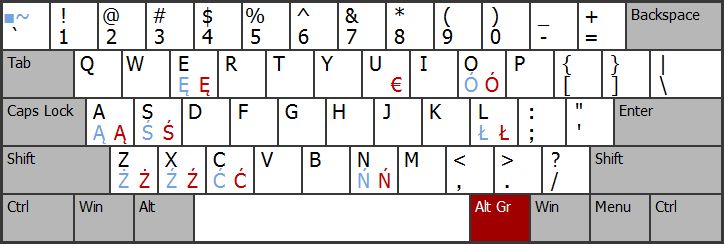
Special Polish letters are entered either with the help of the right-hand Alt key or using the [Shift]+[`] dead key (for example, [Shift]+[`], [a] → [ą]).
[~] symbol may be entered by means of combining the dead key with Spacebar: [Shift]+[`], [Spacebar] → [~].
(this layout may be downloaded here)

Symbols denoted with red color may be entered with the help of both the right-hand Alt button and the extra [`] dead key (for example, [`], [u] → [€] or [`], [Shift]+[a] → [Ą]). Symbols denoted with orange color may only be entered with [Alt Gr].
[`] and [~] symbols are entered by means of combining the corresponding dead key with Spacebar: [`], [Spacebar] → [`], [Shift]+[`], [Spacebar] → [~].

Light-grey letter “a” denotes combining tone diacritical marks. These marks have to be entered after the respective vowels. Right-hand Alt key duplicates the US standard keyboard. Red color denotes symbols that may be entered only with the help of the right-hand Alt key. Pink color denotes symbols that may be entered either with the right-hand Alt key or without it.
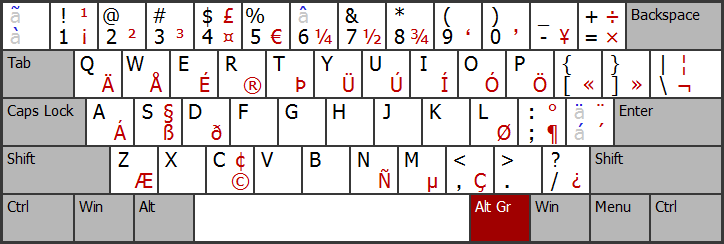
Supports all the primary Western European languages.
[`], [~], [^], ['], and ["] symbols may be entered by combining a dead key ([à], [ã], [â], [á], and [ä], respectively) with Spacebar (for example, [dead à], [Spacebar] → [`], [Shift]+[dead à], [Spacebar] → [~] or [Shift]+[dead á], [Spacebar] → ["]).
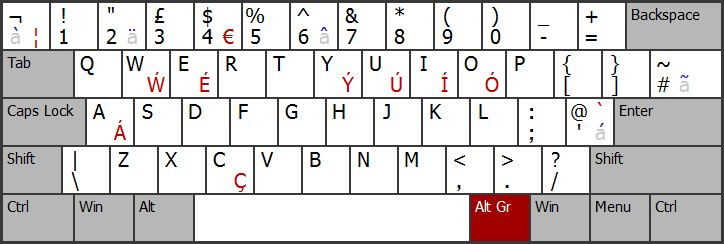
This is an almost transparent replacement for the standard United Kingdom keyboard, the only difference being the [à] dead key (if not to take into account those extra symbols that are entered with the help of the right-hand Alt key).

This layout supports all the contemporary Slavic languages with Latin-based alphabets, as well as the most common Western European languages and Hungarian.
To enter [^] symbol, use the respective dead key in combination with Spacebar: [Alt Gr]+[3], [Spacebar] → [^].
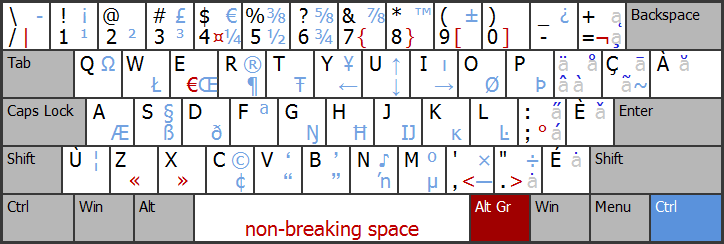
Entering of special symbols denoted with red color, as well as dead keys depicted in the middle columns, are activated with right-hand Alt key. Entering of letters and special keys denoted with blue color, as well as dead keys depicted in the right-hand columns, are activated with right-hand Ctrl key.
[Right Ctrl]+[Shift]+[/] key combination produces soft hyphen (an invisible symbol that permits division of a word).
[^] symbol, as well as interpunct [·] and free-standing diacritical marks ([¸], [˛], [¨], [`], [˚], [¯], [´], [˝], [˘], and [ˇ]), may be entered by using the respective dead key in combination with Spacebar: [dead â], [Spacebar] → [^], [Right Ctrl]+[.], [Spacebar] → [·], and so on.
(this layout may be downloaded here)
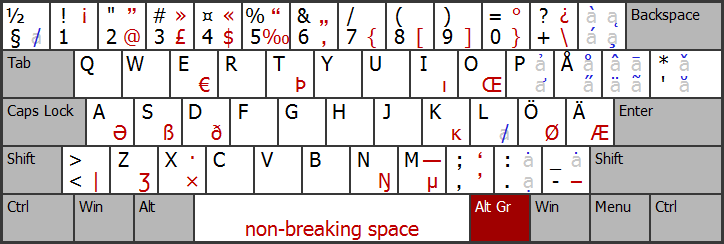
Supports an extremely wide range of letters and still affords much space for further expansion. Apparently makes it possible to enter texts in the whole multitude of European languages, as well as in Vietnamese and a great number of others.
(this layout may be downloaded here)
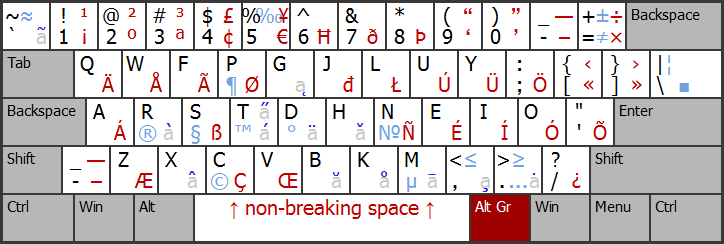
Supports all the contemporary European languages with the exception of Sami and perhaps a few other very exotic ones. Detailed description with complete list of the available symbols may be found at the layout’s official site.
Blue color denotes symbols entered in combination with [Alt Gr]+[\] (for example, [Alt Gr]+[\], [c] → [©] or [Alt Gr]+[\], [Shift]+[.] → [≥]).
Non-breaking space is entered in the following way: [Alt Gr]+[Shift]+[Spacebar] → [ ].

Green color denotes differences between standard Russian and Belarusian layouts; blue color denotes differences between standard Russian layout and “Ukranian (Enhanced)” one (available in Windows Vista and above).
[Alt Gr] key is used in the Ukranian layout only, being responsible for the single letter “ge with upturn” [Ґґ], denoted here with red color.
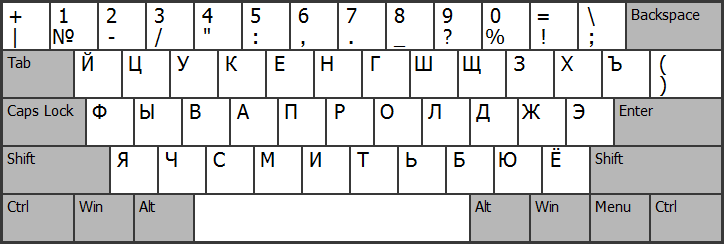

This version of the layout is available in Windows Vista and above.
Uppercase versions of [Ь] and [Ы] letters may be entered as well, but only when Caps Lock mode is active. Uppercase version of [Ѝ] letter may be entered using the extra key available on European keyboards, and alternatively in a way similar to that of [Ы] letter (with [Shift] button being hold while in Caps Lock mode).

The sole dead key is used for entering of Macenodian letters [Ѓѓ] and [Ќќ], and also for the typewriter aposhtophe (in combination with Spacebar): [dead á], [Кк] → [Ќќ], [dead á], [Spacebar] → ['].
(this layout may be downloaded here)
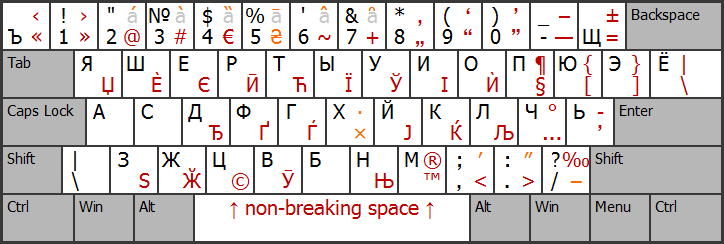
Supports all the contemporary Slavic languages with Cyrillic-based alphabets, as well as the most important typographic symbols.

(this layout for Windows 95/XP may be downloaded here)
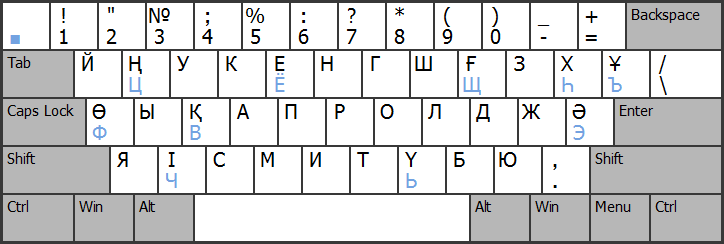
Being highly compatible with the standard Russian keyboard, this layout uses a dead key to enter Russian letters that are not typical to Kazakh language.
(this layout may be downloaded here)
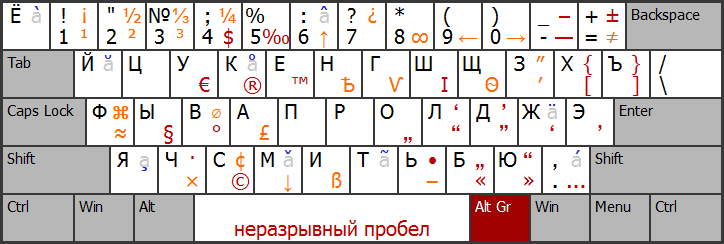

Provides an exceptionally convenient way of entering both Russian and English quotation marks as well as support for most common Western European languages and a multitude of useful typographic symbols.

By combining dead keys with Spacebar, one may enter free-standing Greek accent marks (for example, [dead ά], [Spacebar] → [΄] or [Shift]+[ς], [Spacebar] → [΅]).
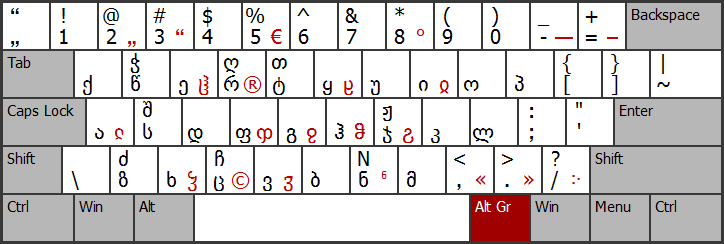
This layout is available in Windows Vista and above.